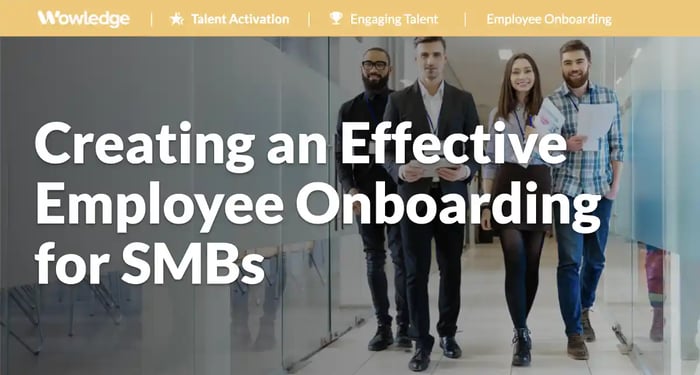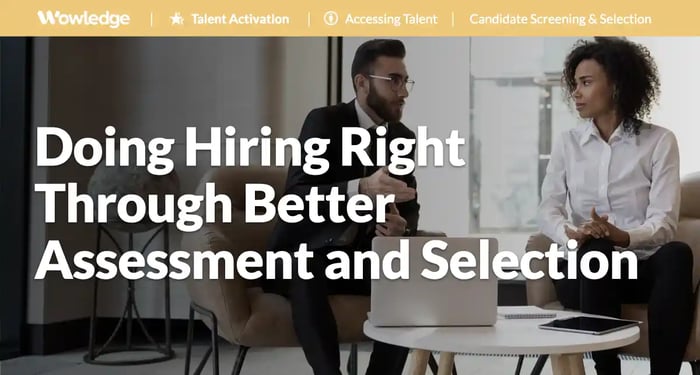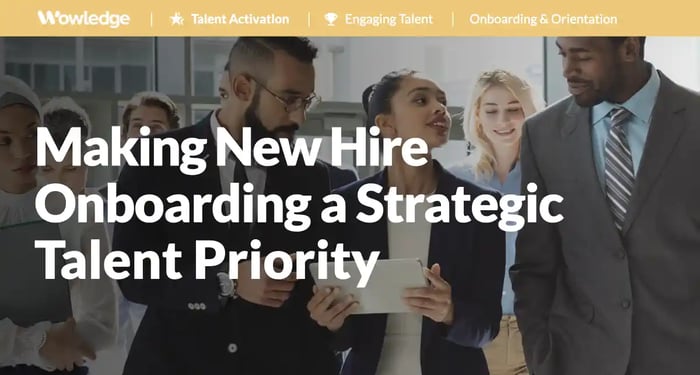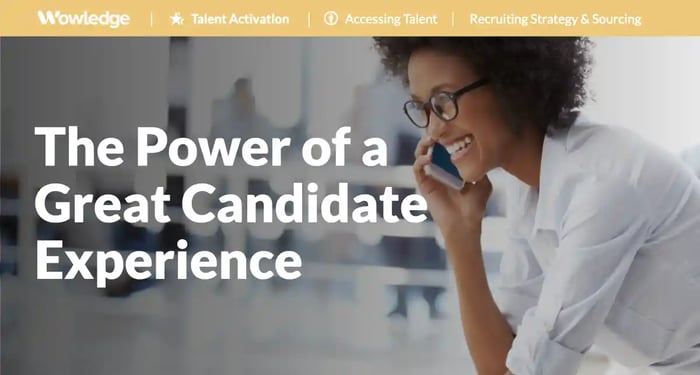Table of Contents
- Why worry about employee onboarding for SMBs right now?
- Understanding the full breadth of new hire onboarding
- The business case for robust employee onboarding for SMBs
- The silver lining that makes quality employee onboarding for SMBs realistic
- The core principles for building an effective employee onboarding for SMBs
- Establishing the process for employee onboarding for SMBs
- Considering employee onboarding technology solutions for SMBs
- Relevant Practices & Tools
- About Wowledge
When it comes to creating high-impact HR in under-resourced organizations, the plight of small-to-medium-sized businesses (SMBs) stands out from the crowd. Consider the fact that 99.9% of US businesses (33.2 million) are small, with fewer than 500 employees, yet create 63% of new jobs in the U.S. They employ 46% of the U.S. workforce and generate 43.5% of the nation’s gross domestic product (GDP). Their ability to attract, hire, and retain their share of continuously shrinking labor pools to meet operational growth needs is compromised by early-tenure turnover rates, putting even greater pressure on their overhead budgets and recruiting processes and standards. The demonstrated power of great employee onboarding for SMBs can act as a salve and solution to many of those challenges.
Why worry about employee onboarding for SMBs right now?
Small businesses face disproportionate impacts from pressures arising from economic uncertainties, financial concerns (including revenue, cost, and borrowing), global supply chain challenges, and governmental policy changes. Their ability to offset and manage those requires stability in their workforces, since small numbers of employees mean that every loss through turnover is more impactful and painful than in larger employers. Employee retention is therefore a larger concern and opportunity for SMBs, and a robust onboarding capability can increase the return on investment (ROI) of budgets and efforts expended on recruiting, training, and assimilating new hires.
Furthermore, successfully assimilating new hires into an organization drives a greater focus on their subsequent adoption and demonstration of shared values (e.g., enhancing product and service quality, customer focus, and success) and contributions to achieving business objectives (e.g., increasing market share, managing costs).
The facts should motivate business and HR leaders at small and medium-sized organizations. For example, BambooHR research found that 44% of new hires regret their decision to accept a job after only one week, and 70% decide within the first 44 days whether they will stay or start looking anew for a different organization.
Understanding the full breadth of new hire onboarding
New hire onboarding refers to the assimilation of recently hired workers during the time period that starts when a job candidate accepts an employment offer through the point in time when they are:
- Fully capable and competent in their job performance, as when they are rated as “meets expectations” or higher, capable of completing all required tasks without supervision.
- Culturally adapted, as the point when they exhibit an understanding and demonstration of communication styles, behaviors, and practices that are consistent with company values and the expectations of all employees.
- Socially integrated, such that they have developed a reputation as, and a network of constructive relationships with collaborators, managers, mentors, and friends.
What this means is that employee onboarding for SMBs starts before the first day of paid employment, and goes well beyond the first days, weeks, or even months. It is much more than a new hire orientation, which is a company-guided Day One activity that often involves a mechanical recitation of company history and mission, payroll and benefits presentations, guidance on policies and procedures, and paperwork completion. While it should be a part of a new hire onboarding process, by itself, it is an insufficient start to the employee journey or employee experience.

The business case for robust employee onboarding for SMBs
While an SMB HR team, much like the broader organization it supports, tends to have fewer staff and more restrictive budget resources, it is precisely those circumstances that establish a case for improving the onboarding process. The price of poor onboarding is well established in lost productivity, higher turnover, lower engagement, and lower employee satisfaction with their decision to accept the job.
For example, Gallup found that only 12% of new hires report that their company does a great job of onboarding new employees. In contrast, it reported that 70% of employees who have exceptional onboarding experiences are 2.6 times more likely to be extremely satisfied with their workplace and have longer tenures as a result.
Other key reasons for creating more effective processes and practices for employee onboarding for SMBs include:
Budget pressures
The tighter budget management required in many small and mid-sized businesses drives an increased need to generate better ROIs from recruiting spending and efforts. Consider just the recurring costs of technology, recruiters’, hiring managers’, and team members’ time and effort spent conducting multiple interviews, documenting those, and making decisions. Using SHRM’s average cost-per-hire estimate of $4,700, along with Training Magazine’s average annual SMB cost of training per employee at $1,050, along with the productivity lost when a job is unoccupied, and the new hire is getting up to speed, the cost of turnover easily exceeds $10,000 per departed worker.
Fewer employees
With a smaller workforce, SMBs have less margin for error in staffing decisions and budgets. The talent risk profile is therefore more pronounced in smaller companies. They have fewer people performing the same or overlapping roles, so the loss of any given individual can result in capability gaps in critical roles that may persist for months. However, fewer employees can also translate into fewer new hires, which creates opportunities to make improvements in the onboarding process.
New hire retention
Annual new hire turnover rates estimated to be 16.7% have been a challenge for years. In fact, Fortune magazine reported in March 2023 that 80% of new hires who receive a poor onboarding experience subsequently plan to quit. The new hire turnover issues continue to be driven by some very recognizable and common experiences of recently hired employees:
- 65% do not know who to go to with their questions
- 62% have insufficient training on company products and services
- 58% lack access to essential tools
- 51% have work technology issues
Perhaps most concerning are the 44% of survey respondents who are “unclear about who their manager is."
The cost of losing nearly 17% of new hires is financially tangible, but the intangible costs of losing new hires can be equally substantial. Consider the effect of a “rotating door” of employment on remaining employees who must “pick up the slack”, retain a positive attitude about their work, workplace, and culture when peers join enthusiastically, and then abandon the opportunity and organization.
New hire “no-show” rates
New hire “ghosting” occurs when an applicant accepts a job offer but then fails to show up on their agreed-upon first day of employment. Sadly, 70% of employers report ghosting rates of up to 25% of their new hires. A possible reason for increased occurrences? 87% of surveyed Gen Z’ers admitted to ghosting at least one employer in the past year.
Indeed’s research points to increases in this phenomenon over the past several years, explaining that some 70% of job seekers report doing it as “payback” to employers who have ghosted them either after submitting an application (35%), or after the second or third round of interviews (40%). The latter statistic is shocking, as personal rapport and relationships are supposed to be built during employee selection processes. Even after offers are extended, no-show rates are driven by poor recruiter communication and pay or benefits levels not meeting candidate expectations that were set earlier in the process.
Talent shortages
All employers, regardless of size or scale, must address their staffing needs in light of global talent and skill shortages. For SMBs, however, the problem is magnified by some of the issues mentioned above, especially those related to limited staff and restricted budgets. The need to manage new hires and get as much return from each one as possible is paramount. Particularly in cases where volume hires (manufacturing, healthcare, retail) are the norm, early and high turnover rates are more common. But it is in the recruiting and hiring of critical skills employees, such as those related to technology, automation, design and development, or data science and analytics, or skilled workers in remote, high-cost-of-living, or less desirable locations, where difficulties multiply rapidly. Effective strategies for employee onboarding for SMBs are essential to engage and retain workers who are hired in such roles or circumstances.
The silver lining that makes quality employee onboarding for SMBs realistic
Despite all the research about poor results from onboarding and negative news about new hire behavior, the beauty of the circumstances is that they favor the creation of highly responsive and effective practices for employee onboarding for SMBs. The beauty of this is that it does not require major investments in technology, complex processes, increased overhead budgets, or skill development. Smaller organizations also benefit from having fewer people and less complexity, making it easier to introduce their mission, values, resources, and key players than in larger ones. Furthermore, given the nature of onboarding as a critical element of the employee experience or journey, it is essentially a humanistic process. The key is to start by listening to employees about their experiences and frustrations.
Consider the finding reported by ihrimedia.com that 36% of employers do not offer a structured onboarding process, and 81% of new hires feel overwhelmed with information during the onboarding process. Fortune magazine found that almost one-third of employees left the process confused instead of enlightened and excited, and small company employees were more likely to be less satisfied with their new hire onboarding to the extent that 66% were planning to quit soon as a result. Use those as starting points for establishing a process for employee onboarding for SMBs that makes joining the company an exciting, engaging, and motivating experience.

The core principles for building an effective employee onboarding for SMBs
1. Create an experience
Consider the post-acceptance through first-year period as a crucial phase in the journey of a long-tenured, highly engaged, culturally-aligned contributor who grows with and for the business. Use basic employee listening approaches and design thinking methods to identify new hire preferences and needs. Make the first year a welcoming experience that embraces the new hire and helps them adapt to the company’s mission, values, standards, and expectations.
New hire onboarding best practices include a structured approach that starts with preboarding, prepares a welcoming and efficient first day, provides clear guidance on company culture and values, sets clear expectations with a 30-60-90 day plan, fosters connections through mentors and buddies, schedules regular check-ins, and integrates new hires socially through team-building activities.
2. Keep it simple
Consider how new hires often complain about orientation being overwhelming, with executive speeches, company presentations, completing forms, making benefits and investment choices, meeting dozens of other people, understanding their new job requirements and goals, finding where to get lunch, and on and on. The key is to walk in their shoes, and prioritize what knowledge and action are essential immediately, needed to start learning and adjusting to their new role, clarifying the people connections needed immediately, and what can be learned as time goes on over a period of weeks or months.
The research reported by Fortune asked employees what they wanted from onboarding, and found that their priorities were: getting to know their teammates, enjoying an “epic welcome”, keeping the process “simple”, understanding career development resources and options, and being assigned a new hire buddy.
3. Onboard comprehensively
An effective process for employee onboarding for SMBs should address all elements of indoctrinating and assimilating new hires, which means leaving nothing to chance. Engage all aspects of a new hire experience in ways that make them feel welcomed, challenged, and developed. Build first-year engagement through meaningful addressing of the who, where, how, and why their work will be performed, including initial work requirements and goals, cultural assimilation, social bonding, skills adaptation, and cognitive engagement through development and initial assignments.
4. Design standardized processes
Make onboarding a relatively structured process with a clear schedule of activities and actions, along with clear accountabilities for administering, executing, and following up. Create checklists for new hires, co-workers, managers, mentors, and support functions such as HR, IT, Security, Purchasing, Administration, and Facilities. Avoid overwhelming and frustrating new hires by creating timelines that allow for absorption over time.
5. Measure activity, participation, and outcomes
Wherever possible, create mechanisms to assess and track the successful execution and completion of required and best practice activities. Stay in touch with new hires and their managers throughout the onboarding process to evaluate their level of satisfaction, issues and concerns, and opportunities to resolve those issues quickly and effectively. Use existing employee listening (or engagement) surveys, create brief pulse surveys and “stay interviews” to get a sense of the state of their affairs, and use exit interviews for new hire terminations to determine the reasons and key drivers of early-tenure turnover. Ask questions related to traditional retention vs. turnover factors such as work-life balance, stress, managerial coaching and support, and development and advancement opportunities.

Establishing the process for employee onboarding for SMBs
A new hire onboarding process at a small or midsize business can be created and administered on an affordable but effective basis, as long as there is an awareness of its value, support by senior leadership, and a commitment to making new hires feel welcomed, valued, and quickly integrated into the organization. The key is to focus on what is needed for them to reach full productivity quickly, understand and act in accordance with company values and cultural standards, adapt to and follow work processes, meet expectations for collaboration and interaction, and accept (or conduct) supervision.
Some of these might be disallowed for non-exempt new hires in the U.S., unless they meet four criteria: 1) occur outside regular work hours, 2) are voluntary, 3) are not directly related to their future job duties, and 4) produce no “productive” work that will be outcomes of their future duties and responsibilities. Options for paid time to perform any pre-hire onboarding activities must be made available on or after the first day of employment.
Examples of time-based leading practices in employee onboarding for SMBs include many low-cost actions and activities that are effective at assimilating, enculturating, and ramping new hires.
Post-offer acceptance
- Hiring manager calls the new hire and sends a welcome note with next steps.
- Co-workers initiate engagement with individual messages, group video welcome call, sharing of profiles, roles, and experience bases.
- Send link to a new employee profile (“about me”) for them to complete (with good examples).
- Send a new hire welcome kit with informational materials, and company-logo items (mug, hat, shirt, mousepad, digital links to use in posting on social media).
Preboarding
- Employee badge, equipment, systems accounts, facilities access, workspace assignment ordered, approved, and prepared to be ready and available on the first day of employment.
- Payroll, HRIS, employee benefits enrollment, parking, and badge photo materials and links sent.
- First-day agenda, parking information, facility maps, and who to contact upon arrival sent.
- Access to onboarding information with company values and culture, maps, policies, handbook, resources, action items, and to-do lists.
Start date
- Welcome the new hire personally and introduce them to their team. Invite them to lunch with their new manager and coworkers.
- Participate in the company's new hire orientation, covering company policies, values, required enrollments, and providing a comprehensive overview of the organization's mission and vision.
- Assign a buddy, coach, and/or mentor to provide guidance, help them navigate the organization, and answer questions.
- Provide a schedule and milestones that give a clear agenda for the first few weeks, including details about required tasks, meetings, and events.
Initial 1-3 weeks
- Meet with the assigned manager for initial productivity planning, including outlining initial assignments, online and live training requirements, and recommendations for skill adaptation and enhancements.
- Introduction to company tools and methods, including calendaring, email, texting, collaboration platforms, knowledge management (KM) systems, and project management suites.
- Share administrative activity requirements and expectations, including status reporting, manager check-ins, and who to ask for help.
- Guidance and resources on how to perform the job, unique terminology, and knowledge transfer opportunities, and people and resources.
Ongoing Onboarding
Job and task-related
- Develop a 30-60-90 day plan that outlines clear, measurable goals and expectations for the first three months to guide the new hire's ramp-up, learning, and integration.
- Set clear annual performance requirements and standards, including goals, objectives, and performance metrics.
- Identify key partners, colleagues, and leaders to schedule meetings with, including the reasons and agendas for each, and their contact information.
Coaching and development
- Schedule regular check-ins with the manager to maintain open communication and performance support feedback and support related to work productivity, onboarding tasks, creating connections, and comfort with new relationships.
- Provide guidance, resources, and expectations for preparing for check-ins, formal, and periodic performance reviews.
- Assign new hires to special project teams that leverage their existing skills or develop new specialized capabilities.
Enculturation and assimilation
- Foster social integration through team lunches, events, pairing for work assignments, and encouraging collaboration to help new hires build relationships.
- Enable an expansion of connections outside of immediate team members to build their own networks, such as through social groups, employee resource groups (ERGs), community involvement activities, and participation on internal collaboration platforms.
Considering employee onboarding technology solutions for SMBs
SMB’s have automated, online options in the market that can enable more structured and reliable processes for their new hires and managers. With the goal of providing a consistently complete and engaging experience, these systems can simplify and reduce the workload for new employees, administrators, and managers alike. Many of them can be tailored by location, role, function, job level, or department, used for virtual or onsite onboarding, and use e-signatures for non-local acceptances and subsequent data or form submissions and enrollments. The most interesting platforms automate workflows, checklists, reminders, and provisioning, and leverage gamification and AI to deliver highly engaging and personalized user experiences. The automated capabilities to look for when researching available options include:
- Offer letters
- Total rewards statements
- Pre-boarding activities – forms, company information, benefits, policies
- Checklists, task assignments, and reminders for new hires, hiring managers, HRIS, payroll, benefits, IT, security, purchasing, facilities, and health and safety
- Welcome videos
- Training guides and program recommendations
- Who to contact (and how) for questions and issues
- Employee profiles and a searchable people directory
- Organization charts
- New hire announcements
- New hire surveys
Useful recommendations and reviews can be found from Gartner, Capterra, and Zapier.
Relevant Practices & Tools
Emerging Career Development Practices that are Business Driven, Intelligent, and Offer Elite-level Development. >
Emerging career development is a business strategy-driven function that creates linkages between a company's strategic staffing needs and individuals' career aspirations... more »
Building a Culture of Coaching and Mentoring that Creates a Continuous Learning and Improvement Environment. >
Establishing and managing a sustainable culture of coaching and mentoring is an integrated effort that builds an environment where continuous development and growth take center stage... more »
Creating Informal Learning and Experiential Development Opportunities for Cost-effective Delivery. >
Informal learning includes any learning or development activity that a) takes place outside of a formal classroom or educational setting, b) is self-initiated or guided, and c) aims to improve or develop practical knowledge, skills, and abilities (KSAs) for a current job or aspirational role... more »
Using Human-Centered Design to Build Employee and Customer-Focused Innovation Initiatives. >
Human-centered design is an approach to innovation that grounds any initiative (service, program, or product) in real human needs by engaging the end-users in the design process... more »
The Learning Plan: Outline Learning Objectives, Skills, Delivery Methods, and Evaluation Criteria to Guide Effective Development Programs. >
This tool helps structure professional development initiatives by defining what employees need to learn, how learning will be delivered, and how success will be measured... more »
About Wowledge
Wowledge is the implementation-first platform designed for lean HR teams and consultants who need to design and scale strategic HR programs efficiently—without starting from scratch.
Our members gain access to continuously updated best practices, step-by-step guidance, expert-built tools, and customizable templates—all structured to accelerate the development and implementation of key HR programs.
Recognizing that every organization operates at different levels of sophistication, Wowledge’s scalable system of best practices follows a stage-based approach—Core, Advanced, and Emerging—ensuring HR professionals can implement solutions tailored to their organization’s unique needs and goals.
Your Shortcut to Amplifying HR Impact!
Get started for FREE! Learn more.










